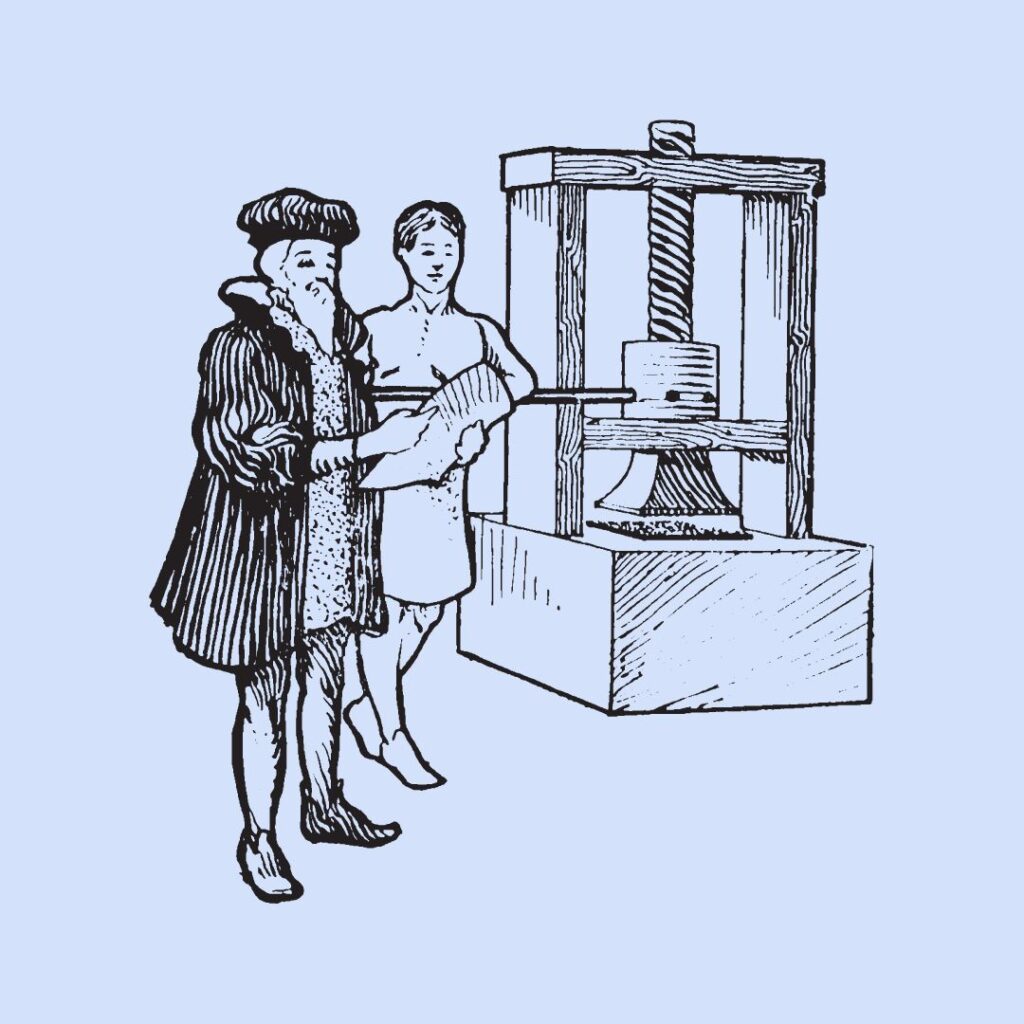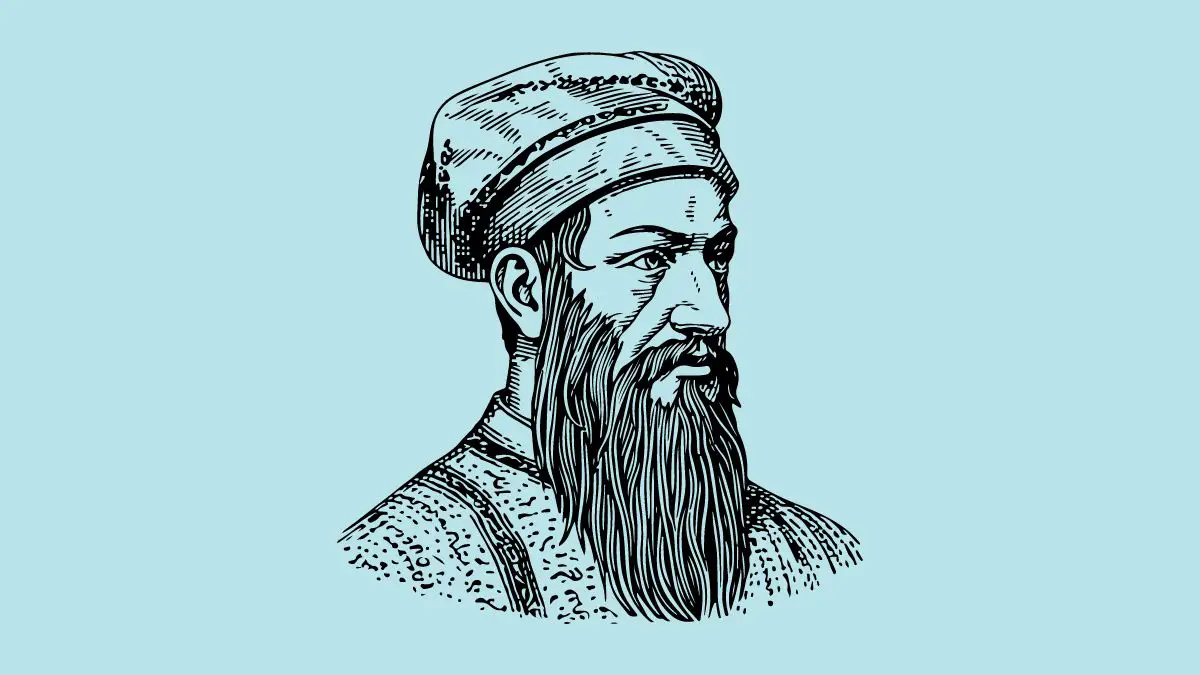Table of Contents
- Introduction
- 1. Early Life in Mainz
- 2. Family Background
- 3. Goldsmithing and Metalworking
- 4. The Mystery of His Early Career
- 5. The Revolutionary Movable-Type Printing Press
- 6. The Gutenberg Bible
- 7. Financial Struggles and Lawsuits
- 8. Gutenberg’s Partnership with Johann Fust
- 9. Peter Schoeffer: The Forgotten Partner
- 10. Impact on the Renaissance and Reformation
- 11. Print Runs of the Bible
- 12. Gutenberg’s Influence on Language Standardization
- 13. The Spread of Printing Across Europe
- 14. Limited Recognition in His Lifetime
- 15. Gutenberg’s Later Years
- 16. Gutenberg’s Death
- 17. The Gutenberg Galaxy
- 18. Gutenberg’s Impact on Education
- 19. Gutenberg’s Printing Method: Not the First
- 20. The Gutenberg Museum
- Conclusion
Introduction
Johannes Gutenberg, a name synonymous with the invention of the movable-type printing press, is one of the most influential figures in history. His groundbreaking innovation in the 15th century paved the way for mass communication, profoundly altering the course of human civilization.
While many people are familiar with his printing press, Gutenberg’s life and the full scope of his contributions remain lesser-known. This article delves into 20 interesting things about Johannes Gutenberg, providing a deeper insight into the man whose work revolutionized the world.
1. Early Life in Mainz
Johannes Gutenberg was born around 1400 in the city of Mainz, in what is now modern-day Germany. His birth name was not actually “Gutenberg.” He was born Johannes Gensfleisch zur Laden but later adopted his mother’s maiden name, “Gutenberg,” derived from the family house’s name.
2. Family Background
Gutenberg came from a wealthy family of merchants and craftsmen. His father, Friele Gensfleisch zur Laden, worked as a patrician and may have held a position in the city’s mint, where coin production was one of the city’s key trades. This exposure to metalworking from an early age possibly contributed to Gutenberg’s later innovations in printing.
3. Goldsmithing and Metalworking
Before becoming an inventor, Gutenberg was trained as a goldsmith. His knowledge of metalwork, particularly in molding and casting metals, played a critical role in his development of movable type. This technical skill allowed him to create durable, interchangeable metal letters, a key aspect of his printing press.
4. The Mystery of His Early Career
There is a notable gap in the historical record concerning Gutenberg’s early adulthood. It is believed that he may have worked as a craftsman in Strasbourg, France, during the 1430s and early 1440s. During this period, he likely honed his skills in metalwork and began experimenting with printing technologies.
5. The Revolutionary Movable-Type Printing Press
Gutenberg’s most significant contribution to history is the movable-type printing press. Before this invention, scribes manually copied books, a laborious and time-consuming process. Gutenberg’s press enabled the mass production of books and other written materials, reducing costs and increasing access to knowledge. His press used individual, movable letters made from metal, which could be rearranged to print different texts.
6. The Gutenberg Bible
The most famous work produced by Gutenberg’s press was the Gutenberg Bible, also known as the 42-line Bible. Printed in the mid-1450s, it is considered the first major book printed using movable type in the West. The Bible was remarkable not only for its technical achievement but also for its beauty, with large, clear type and exquisite illustrations. Today, only about 50 copies of the Gutenberg Bible survive, many of which are incomplete.
7. Financial Struggles and Lawsuits
Despite the revolutionary nature of his invention, Gutenberg faced significant financial difficulties. His printing operation was an expensive set-up, and he needed substantial loans to fund it. One of his primary backers, Johann Fust, eventually sued Gutenberg for failing to repay the loans. In 1455, Gutenberg lost the lawsuit, and Fust seized control of much of his printing equipment, including the press used to print the Bible.
8. Gutenberg’s Partnership with Johann Fust
Johann Fust was a wealthy financier from Mainz who provided the necessary funds for Gutenberg to establish his printing business. However, their partnership deteriorated, leading to the famous lawsuit in which Gutenberg lost his press and his business to Fust. Interestingly, Fust continued the printing business and eventually became one of the first commercial printers in Europe.
9. Peter Schoeffer: The Forgotten Partner
Peter Schoeffer, a scribe and later Gutenberg’s apprentice, played a significant role in refining Gutenberg’s printing process. After the lawsuit between Fust and Gutenberg, Schoeffer aligned himself with Fust and helped continue the printing enterprise. Some historians believe Schoeffer contributed to improving the design of the movable type, making the process more efficient.
10. Impact on the Renaissance and Reformation
Gutenberg’s invention is often credited with accelerating the spread of the Renaissance. The ability to print books and disseminate knowledge quickly and affordably played a crucial role in the intellectual awakening of Europe. Additionally, the printing press was instrumental in the Protestant Reformation. Martin Luther’s 95 Theses were widely distributed thanks to Gutenberg’s invention, which helped Luther’s ideas reach a broad audience and challenge the Catholic Church.
11. Print Runs of the Bible
It is estimated that around 180 copies of the Gutenberg Bible were printed, of which approximately 150 were printed on paper, and the remaining 30 on vellum, a more expensive material made from calfskin. The rarity and craftsmanship of the vellum copies made them highly prized, even in their time. Today, a single page of a Gutenberg Bible can fetch hundreds of thousands of dollars at auction.
12. Gutenberg’s Influence on Language Standardization
Before the printing press, manuscripts were written in various dialects and languages, making the transmission of ideas across regions difficult. Gutenberg’s press contributed to the standardization of languages by enabling uniform copies of texts. This played a significant role in the development of national languages, as books were now printed in a standardized form, reducing regional dialects’ influence.
13. The Spread of Printing Across Europe
Gutenberg’s invention spread rapidly throughout Europe. Within a few decades, printing presses had been established in numerous cities, including Venice, Paris, and London. By 1500, over 1,000 printing presses were in operation across Europe, producing millions of books and pamphlets. This unprecedented spread of information is often referred to as the “printing revolution.”
14. Limited Recognition in His Lifetime
Although Gutenberg’s press revolutionized communication and knowledge dissemination, he did not receive widespread recognition during his lifetime. His financial struggles and losing his business to Fust overshadowed many of his achievements. It wasn’t until later centuries that historians began to appreciate the full impact of his invention.
15. Gutenberg’s Later Years
Despite his financial setbacks, Gutenberg continued to work in the printing trade. In 1465, he was given an honorary title by Archbishop Adolph of Nassau, which provided him with a stipend and certain privileges, including a court position. This recognition, though limited, ensured that Gutenberg lived his final years in relative comfort.
16. Gutenberg’s Death
Johannes Gutenberg passed away in 1468 in his hometown of Mainz. At the time of his death, his legacy had yet to be fully recognized. However, his invention would soon change the course of history, and he would posthumously be celebrated as one of the most important figures in advancing human knowledge.
17. The Gutenberg Galaxy
The term “Gutenberg Galaxy” was coined by the Canadian philosopher Marshall McLuhan in his 1962 book of the same name. McLuhan used the phrase to describe the cultural and intellectual impact of the printing press, comparing it to a new era in human thought. According to McLuhan, the shift from oral to print culture profoundly transformed society, setting the stage for the modern age.

18. Gutenberg’s Impact on Education
Gutenberg’s press revolutionized education by making books more affordable and accessible. Before the printing press, books were rare and expensive, typically available only to the wealthy or the clergy. With the advent of printed books, literacy rates began to rise as more people could afford to own and read books. Universities and schools also benefited, as they could now acquire multiple copies of texts for teaching.
19. Gutenberg’s Printing Method: Not the First
Though Gutenberg is often credited with inventing the printing press, it’s important to note that printing technology had been developed in other parts of the world long before. In China, block printing had been used as early as the 9th century, and movable type made of clay was invented in Korea during the 13th century. However, Gutenberg’s press was the first to combine movable type with a mechanized press, which made printing much faster and more efficient than previous methods.
20. The Gutenberg Museum
In honor of Johannes Gutenberg and his contributions to printing, the Gutenberg Museum was established in Mainz in 1900. It houses one of the world’s most extensive collections of print-related artifacts, including two original Gutenberg Bibles. The museum serves as a tribute to the man who revolutionized the dissemination of knowledge and provides visitors with a comprehensive overview of the history of printing.
Conclusion
Johannes Gutenberg’s life and work represent a pivotal moment in human history. His invention of the movable-type printing press transformed the publishing industry and democratized access to knowledge, fueling intellectual movements like the Renaissance and the Reformation. While Gutenberg faced personal and financial hardships, his legacy endures as one of the most significant contributions to the advancement of civilization. The impact of his printing press can still be felt today in a world where the printed word continues to shape cultures, spread ideas, and foster communication on a global scale.
Though Gutenberg may not have achieved fame or fortune in his lifetime, his work laid the foundation for the modern world, making him one of history’s most influential figures. Whether through the beautifully printed pages of the Gutenberg Bible or the vast expansion of literacy, Johannes Gutenberg’s impact resonates even in the digital age.
